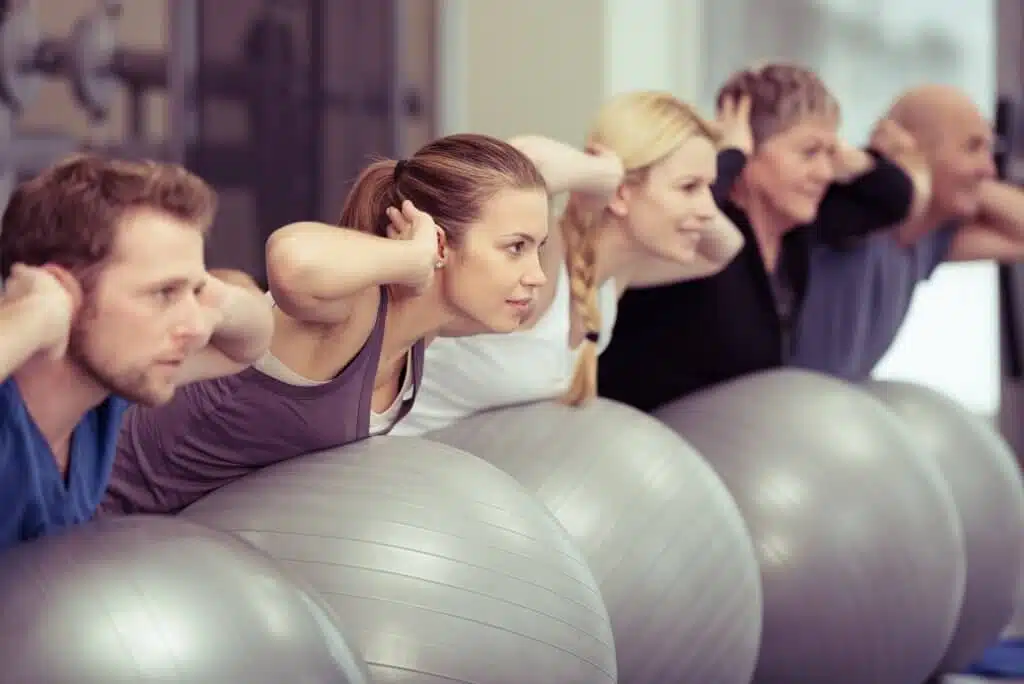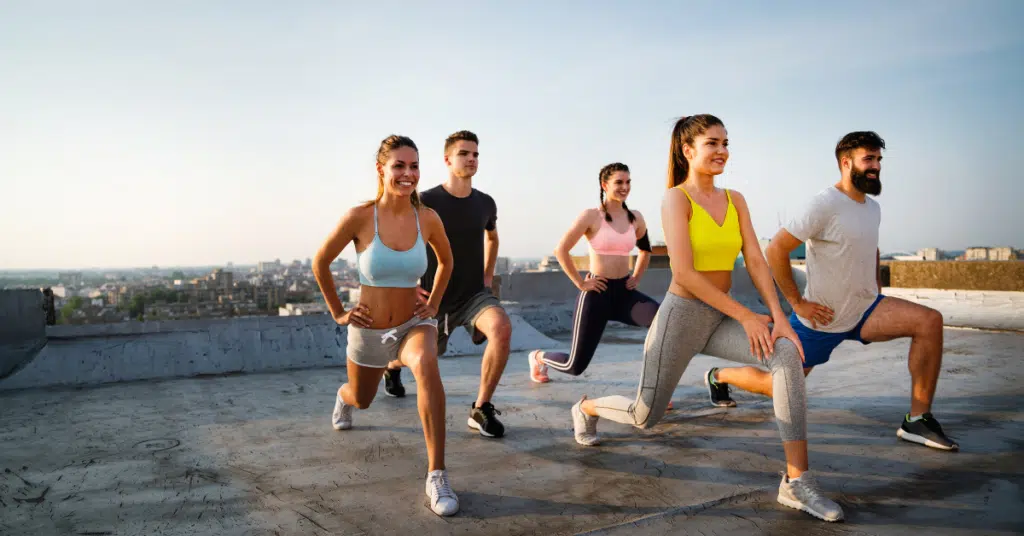

Menu
While the once seemingly unstoppable march of the 24/7 business model within the fitness industry has slowed down considerably, the debate regarding access controls for independent gyms and fitness clubs has never been more dynamic.
With the Covid-19 pandemic and the still ongoing energy cost crisis, the common orthodox that access control automation had made 24-hour Gyms and Fitness Clubs a no-brainer has been challenged. As such, the debate of the last half decade has shifted again, to the most effective and reliable access control solution for each individual gym.
No longer is it enough to just say that a full body turnstile for 24/7 access control is necessary. We operate in a more nuanced market now. So we thought that now was the time to put our 25 years of experience here at Ashbourne to the test. We will be drawing on our knowledge prior to and during the 24/7 revolution to see what life in the ‘aftermath’ looks like for independent gyms and fitness clubs.
We have dealt with independent gyms and fitness clubs of all sizes, shapes and specifications over the years. Each one of our partners and clients have allowed us to learn and adapt in an industry where versatility is truly rewarded.
As the technology involved in access control continues to advance, we thought it was about time to harness our experience and authority and condense it into an article to help new and veteran independent gym owners adapt to this post-Covid, post-energy crisis landscape.
So without further ado we will be taking a look at the different access systems, comparing their pros and cons with specific focus on the current industry situation.
What Should An Independent Gym Or Fitness Club Owner Be Looking For In An Access Control System?
But before we get to comparing and contrasting different access systems, we should look into what we WANT from our control access systems, as well as some specific terminology that will be used over the course of the article.
When we say access control, we are talking about a combination of two factors:
- What is physically stopping a person from accessing your Gym floor until they have verified themselves as a member.
- The verification process itself.
Now while the term process might only evoke new, popular solutions such as fingerprint scanners and passcodes. This process can also be as rudimentary as someone on a desk buzzing/unlocking a barrier for the gym member.
While it might seem obvious, it is important to state that this process can vary wildly from gym to gym. And with 25 years working with independent gyms and fitness clubs we have seen a lot of ‘solutions’.
And so what are we looking for from each of these factors?
Our first factor, is the physical barrier. We want it to be a secure, hard-wearing solution. Hard to break, easy to repair and easy to traverse once the verification process (Step 2) has been completed by the gym member.
A gym entry system has to be a bespoke combination of efficient, secure, easy to use and, if possible, aesthetically satisfying to the customer.
To our second factor, we are looking for a system that is easy to understand, hard to circumvent and reduces the ability for members to share their access information. It should also take minimal time, respecting the time of the member and the staff.
As such, it becomes apparent that a good access control system isn’t just ‘buying the most expensive turnstiles’. It is a decision that has to take into account a Gym’s members, staff, facility and physical constraints.
The access control system that a gym decides to put in place should enhance the experience of the members. If it is a system that members struggle with or find frustrating or difficult to use, this will stick in their mind and be part of what they recall when thinking about the gym. Ideally it should be an extension of the brand, effortless, convenient, efficient.
Because at the core of it an access system isn’t just a FIRST impression that a member gets of an independent gym or fitness club, it is a repeated impression.
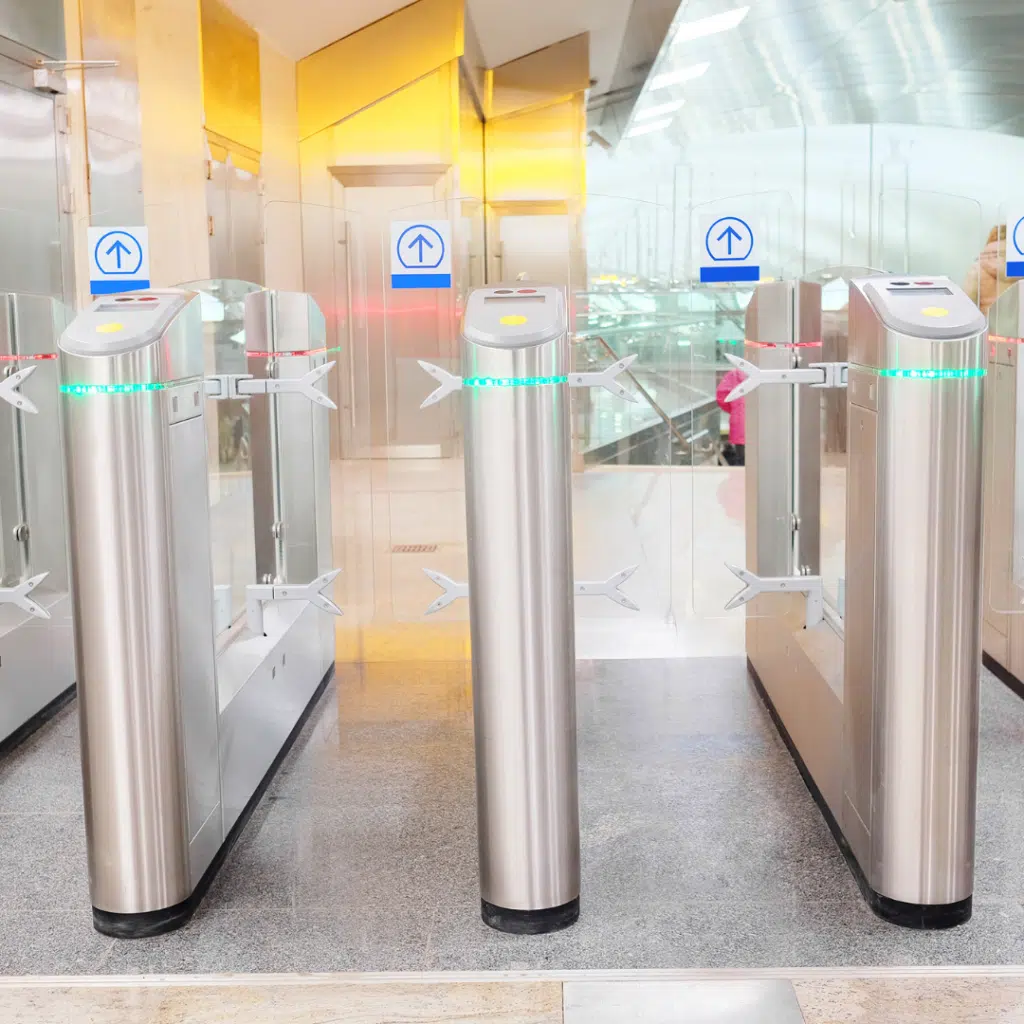
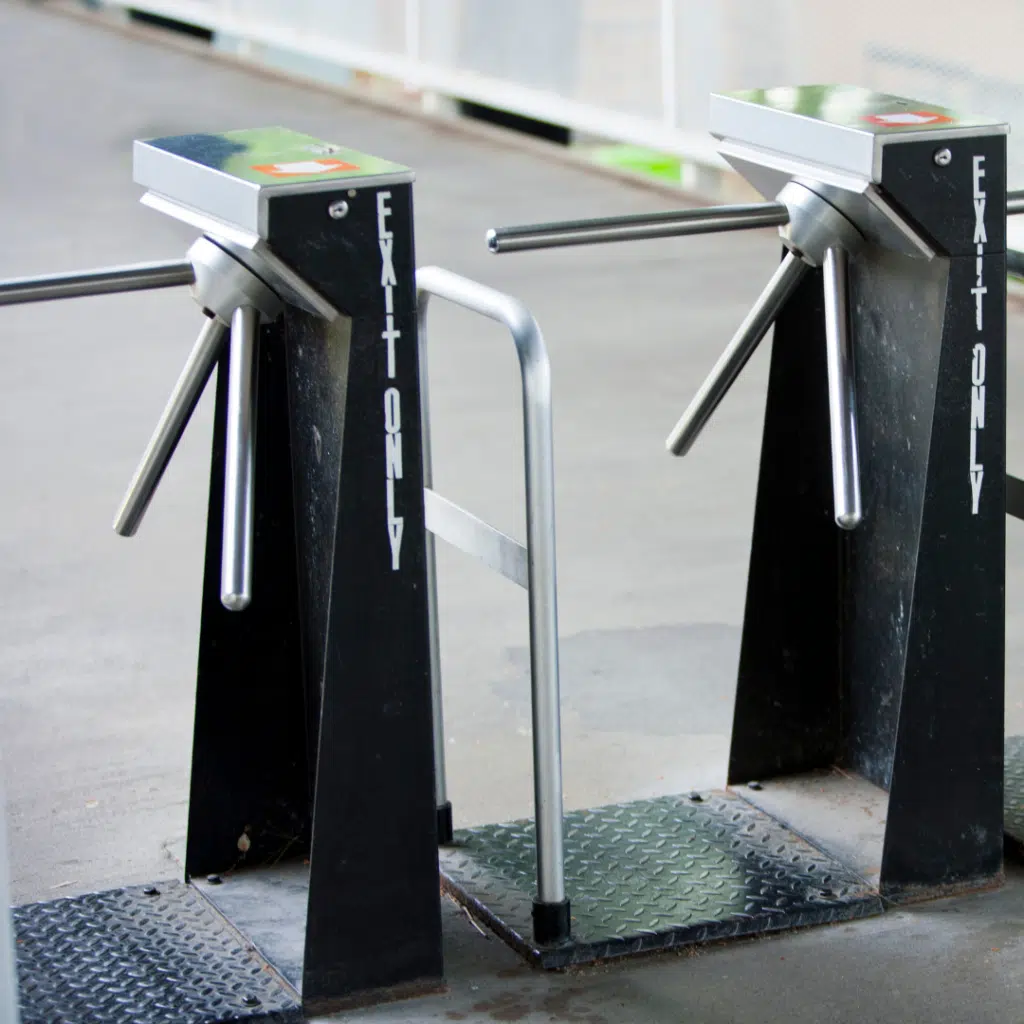
If something is tedious and we only have to do it once, we can quickly forget about it. If something is tedious and we have to do it five times a week. We will remember it for a long, long time.
As such, it is vital that gyms and fitness clubs do not make the actual access procedure a case of ‘death by a thousand cuts’.
Even if the process is going to be rudimentary, it must still be judged on how unobtrusive and time-efficient it is. If the devil is in the detail, this is a detail that gyms will want to nail in order to bolster retention.
So as we’ve worked out that Access control systems for gyms are a puzzle of two halves. We will look at each of these halves in turn. First we will start off with the common and popular access procedures and mechanisms that are used the world over.
After that we will focus on the different types of physical barriers, not just for their role in keeping non-members out, but also measuring the ease of which it allows members into the gym. In addition we will look into different incidents and considerations we have come across in our time, such as their behaviour during power cuts and the level of inconvenience it will cause if they break or are damaged.
As we go through these sections, we will keep in mind why we in the fitness industry employ access control systems for gyms and fitness clubs. That it is not merely a matter of who goes in and out. It is also designed to monitor your members, gain data and use it to enhance their experience within a gym or fitness club.
This can be vital and independent gyms that don’t utilise systems that can capture sufficient data risk losing out on valuable feedback.
When utilised in tandem with the right club management software, access control can be used to transform the way an independent gym or fitness club gains information about their BAU (business as usual) operations.
With all that out of the way, it is time to look into the best access control systems for independent gyms and fitness clubs, starting with the verification process.
Section 1: Membership Verification Systems
First, we will be looking at the verification process. This is the system that gym members will be using to gain access to the gym. It goes without saying that the digital and resultant automation revolution have transformed how gyms are accessed in the last two decades. As such, while we did reference the idea of a staff member manually checking and buzzing people through a gym’s security measures, we are not going to include it on the list.
That is because this system, simply put, is not ideal. Not only is it expensive in terms of staffing costs and manpower, it is also the worst method when it comes to data capture. We appreciate that independent gyms and fitness clubs that are starting out or have incredibly specific opening times might find this solution appealing, but we believe that it is a short-term solution for a long-term problem.
There is an argument to be made about cost, but even then we believe that in the long term, the automated, higher-tech solutions that we are about to recommend will ultimately result not only in a saving but also in a greater scope for development moving forward.
Magnetic Swipe Cards, RFID Cards And Keyfobs
Starting in the physical (albeit still digital) realm, our overview will begin with a collection of access control methods employed by gyms and fitness clubs.
The reason these three methods, Magnetic Swipe Cards, RFID Cards and Keyfobs, have been grouped together is because they share something in common.
Each one relies on a physical object that will interface digitally with the gym or fitness club’s security system. From there, this physical object’s digital signature will confirm that the member is entitled to enter the facility and open the access control system for them.
- RFID, or Radio Frequency Identification cards, have become a staple of not only gyms but office access control. A small, credit card sized card that is pressed against a scanner for a few seconds. We will go over the main drawback with these cards at the end of this section, but compared to their magnetic counterparts they are largely considered reliable and hard-wearing due to their functionality being internal.
- Magnetic Swipe Cards are very similar in concept but rather than being pressed against a pad they are ran through a card reader. This is essentially a different method of interfacing. While popular, we have seen their popularity diminish somewhat due to a tendency to ‘de-sync’. Given these cards are often stored in magnetised wallets or phone cases, this has led to two different issues.
One is that the magnetic stripe becomes scratched away due to repeated use.
The latter is that the magnetic stripe becomes compromised by the magnetic wallets and phones that they are now commonly stored in.
- And finally we have the ‘key fob’. Used by everyone from office blocks to apartment blocks, these little balls of hardened ABS plastic essentially opt to store the aforementioned digital signature in something a little more unorthodox than a card. Normally worn on a keyring, they are exceptionally hard-wearing. Given that the scope for customisation is greater than a card, they have become quite popular amongst independent gyms as a method of free advertising. Of the three ‘physical-digital’ hybrid methods, they have the greatest aesthetic potential.
The main appeal of these methods is their simplicity. Their function is easily understood, even if an independent gym or fitness club isn’t appealing to the most tech-savvy crowd. Short of the aforementioned de-magnetisation, the scope for them to fail in their functionality is very limited. They are easily portable and often kept in items such as wallets and keyrings that are hard to forget.
In terms of our digital feedback check, they pass with flying colours. Each will be specific to the gym member in question, and with a suitably sophisticated club management system and software, it will give all the necessary feedback and data straight to a BI dashboard.
Furthermore, a branded membership card or stylised key fob can easily be made to reinforce brand identity. If the entry solution to an independent gym or fitness club is simultaneously aesthetically appealing and effortlessly easy, the membership will rightly build a positive connection with the brand. A positive reinforcement loop will start to occur where they associate the keyfob or card with the efficiency that the gym offers on the door.
With all that being said, there is one key (excuse the pun) issue with these fobs and membership cards.
As physical items, they are susceptible to being lost and/or stolen. Both situations are unfortunate, requiring the card to be cancelled, lest the security of the gym or fitness club be compromised.
It is also a method that is very prone to ‘access-sharing’, where people attempt to give out their keyfob or access card to their friends. While staff can be briefed on this, it is ultimately very hard to enforce as it requires the checking of cards. This can feel like a violation of trust to members who are just quietly going about their day.
Once cancelled, the keyfob or card must be reissued. This means keeping a physical supply that has to be given out. In turn, the decision then becomes ‘should members be charged for losing their card, and if so, how much?’. While these are not insurmountable questions, they can cause a degree of hassle for both gym members and gym staff. We would recommend that if an independent gym is considering adopting a key fob or RFID/Magnetic card system, that the management reflect on how these situations will be dealt with, as well as ascertain the cost of maintaining a supply of the cards/fobs.
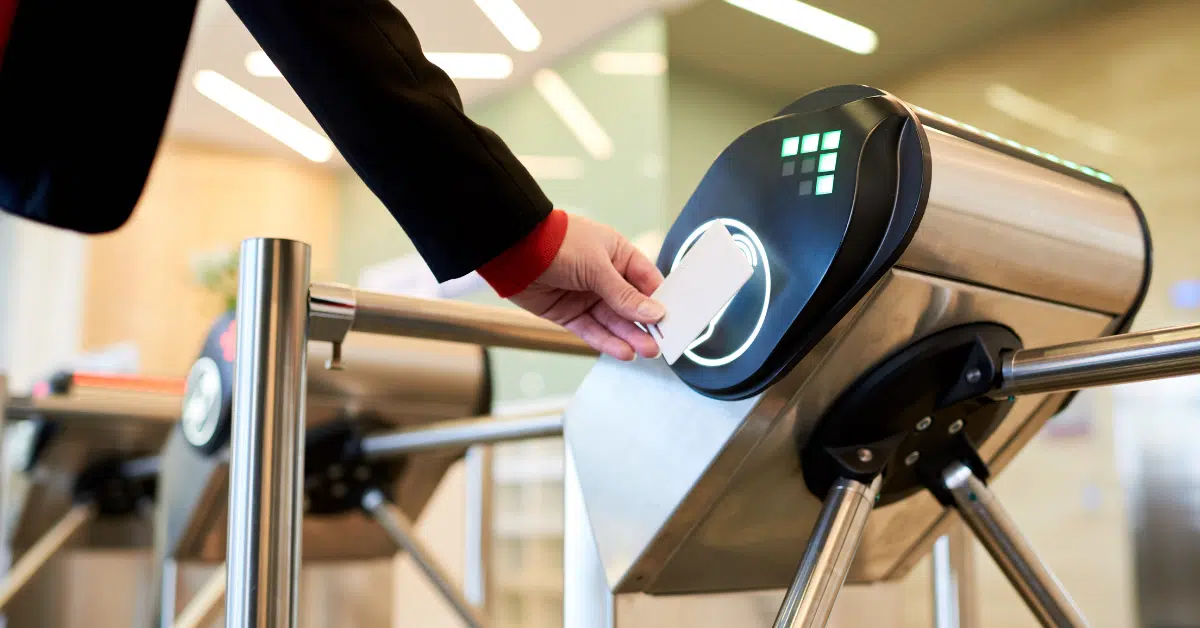
Barcode and QR Code Scanners
The barcode and its pseudo-successor, the QR code, are ubiquitous in modern society, especially in the wake of the Covid-19 lockdowns. Though these are nominally two very different technologies from two different time periods, we have lumped them together for simplicity given that their distribution and functionality are largely interchangeable.
With the number of QR codes generated now running into the hundreds of billions, it is safe to say a few industries have found a way to utilise them! These codes are usually either generated on or sent to a phone application. In specific, more low-tech instances they can also be sent via e-mail.
Both barcodes and QR codes are used the world over, and the fitness industry is no exception. Many independent gyms have latched onto these scanners as a cheap, purely digital alternative to cards and keyfobs.
By removing the reliance on human input, these codes are able to effortlessly transfer a passcode to the access control system, satisfying the criteria for entrance while requiring a digital footprint for our aforementioned data efforts.
Without the need to physically buy, monitor and replace an item such as a card or a keyfob, this system is cost-light and ultra-efficient. It can even be counted towards reducing a carbon footprint, with the diminished use of physical materials!
Ultimately the QR codes and barcodes, while simplistic, are ultimately effective. With the appropriate digital infrastructure behind it, these codes achieve an efficient, easy-to-maintain digital access solution for any independent gym or fitness club.
With that being said, they are not infallible. There is always the risk of members forgetting their means of access, their phones running out of battery, breaking or otherwise being corrupted. In addition, they are not the most intuitive for the technologically illiterate and may require some explanation that could put off older or more luddite-leaning gym members.
Furthermore, this method is very prone to ‘access sharing’, something that plagues many independent gyms and fitness clubs.
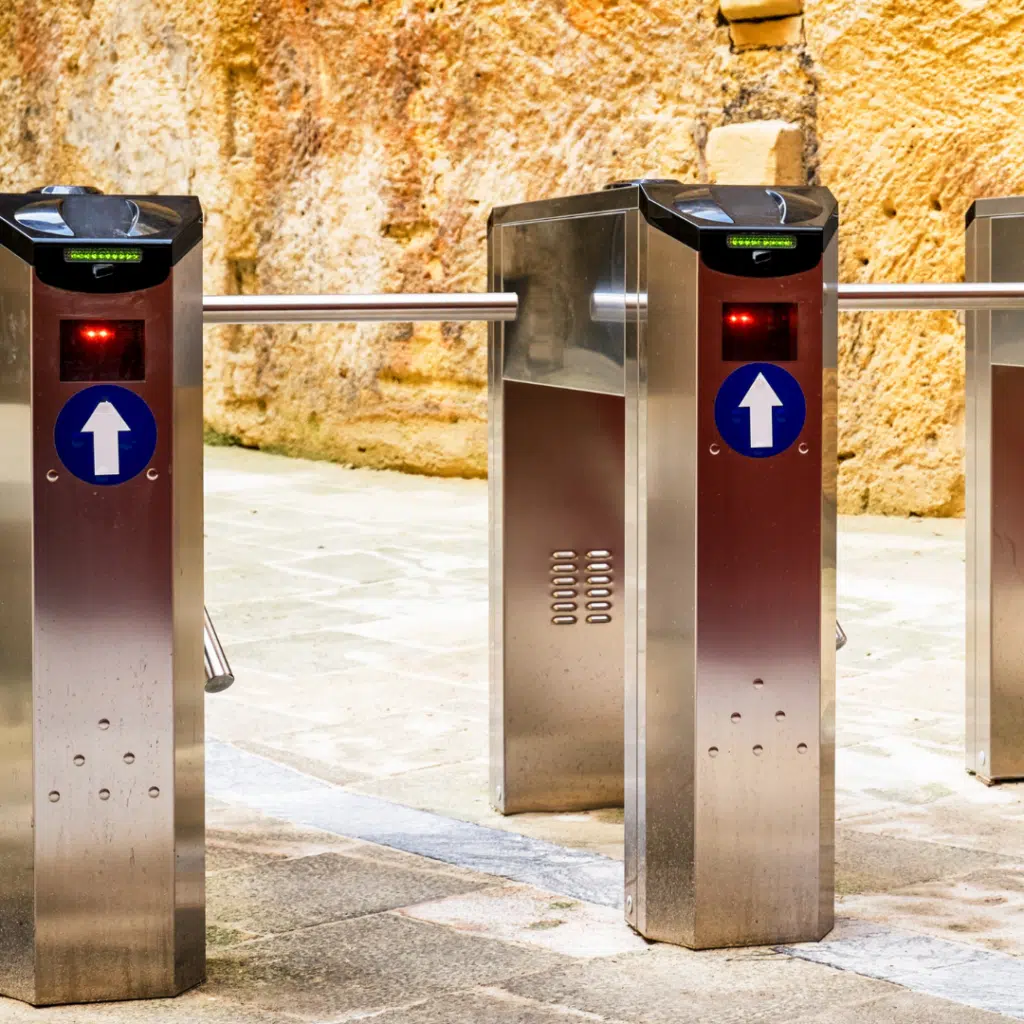
Biometric Scanners
So while the biometric scanner fulfills the same essential function as our other two categories of access control for independent gyms, it does so in a much more futuristic way. By relying on something a gym member (hopefully!) always has on them, their finger.
While the initial effort to collect biometric data and the machinery necessary to use it makes this the most cost-intensive method, the technology has become a lot more accessible and widespread. This can be most evidently seen in life through the rising prevalence on mobile phones. Once seen as a luxury feature, now even budget models come with fingerprint scanners.
While the setup can be more laborious, the payoffs are undeniable. Independent gyms and fitness clubs that invest in biometric scans will adopt an access control system that is easy to use, impossible to forget and unnecessary to replace.
If that isn’t enough of a benefit, this solution also provides the most effortless and satisfying experience providing that the biometric scanners are correctly maintained. Few other solutions feel as futuristic or secure. If an independent gym or fitness club is trying to reinforce the values of its brand via its access control system, we could not recommend a better solution.
Furthermore, it is a system that is basically unable to facilitate the access sharing that has plagued the previous two options that we have investigated.
Section 2: Physical Club Entry Mechanisms and Systems
Now that we have gone through all of the verification methods that we would recommend to one extent or another that can be utilised by an independent gym or fitness club, it is time to look at the other side of the coin.
Namely, what is the physical mechanism stopping non-members from getting in and whether your members are trying to by-pass with a gym’s access control verification system of choice.
We will be looking into quite a few options here, ranging from the expensive and all-conquering, to the simple and functional.
Keeping in mind what we explored at the beginning of this article, that in this post-covid, post-energy crisis bigger is not always better when it comes to the independent gym on a budget.
But without further ado, let us explore the second half of the puzzle that is access control.
Speed Lanes
Starting with one of the more recent access control mechanisms that have been springing up across the fitness industry, we have the Speed Lane system. Designed more for efficiency than security, the speedlane is a light-weight option emphasising aesthetic and ease of use over cast-iron might. Speed is the name of the game…And the lane.
Pros
Designed specifically to feel like a premium experience, speed lanes take inspiration from existing airport security mechanisms. In an age of near-instance everything, the speed lane is supposed to make the gym member feel like the process was near effortless. A small, quickly withdrawn plastic or metal gate will present a small obstacle before the card is presented, only to be whisked away without the member needing to break stride, ideally.
Unlike some of the other solutions that will feature on this list, they are not an eyesore, and can be used to fully showcase an open and aesthetic workout space. This is the access control solution that feels most suited for the generation that has latched onto terms like ‘Zoomer’. Speed, convenience and efficiency is of the essence.

Cons
Unsurprisingly, all that talk of aesthetic and efficiency comes at a cost. A comparative lack of security.
Or rather, a need for additional security measures perhaps. Speed lanes are relatively easy to circumvent and we would not recommend them as the only security solution an independent gym or fitness club uses, especially if they are a 24/7 enterprise.
The ideal place of use for speedlanes is a traffic-heavy gym or fitness club in a relatively secure area that operates purely within daylight/business hours. As such, we would only recommend the speedlane as a specific solution for a specific type of gym, not a catch-all solution.
Swing Gates
Our next access control system that independent gyms can utilise, the Swing Gates, represents a more secure alternative to the Speed lanes. Though, as some might have guessed, at the cost of some speed.
These gates are spacious, which is of course, a double-edged sword. They provide relatively quick and easy access whilst allowing a motorised system to ease the passage of members into the facility without need for them to interact with the gate itself.
Pros
The Swing Gates have several benefits. They are material light, cheap to maintain and easy to repair. Their spacious design allows people with mobility issues or disabilities to navigate through them much easier. This is the cheapest solution that also benefits wheelchair users.
If an independent gym or fitness club is looking to prioritise accessibility, the swing gate should definitely be an avenue that is considered. When compared to the turnstile, it offers a much more reliable situation. While some may require assistance, the number will be significantly reduced. We have even seen some gyms utilising a singular swing gate as an option for those that have accessibility issues.
Cons
With that being said, all this accessibility does lead us to the other side of that double-edged sword. It is very hard to recommend swing gates as a solution for a 24/7 gym or a gym that will not, in some capacity, have their access control system manned and monitored.
Tripod Turnstile
The archetypal three-prolonged turnstile needs little introduction. Perhaps one of the most ubiquitous access control systems in the world. Over a century old and utilised the world over, our question becomes:
Is it a viable solution as an access control system for independent gyms and fitness clubs in the post-lockdown, post-energy crisis 2023 and beyond?
Pros
As the saying goes, it is a classic for a reason. The tripod turnstile is hard-wearing, hard to break and easy to fix. It is a system that is instantly intuitive and uses space efficiently.
Indeed, when compared to more heavy duty solutions, the tripod turnstile can easily come out on top in terms of cost, space and usability.
It is little wonder then that the tripod turnstile has become the staple that it is. When combined with low running costs, it is a system that is remarkably well suited to the post-energy crisis UK and Europe. What goes around comes around we suppose!
Furthermore, the installation of these systems is relatively straightforward and can be adapted to even the most compact gym or fitness club setups. As such, it is no wonder that it is the go-to choice for independent gyms and fitness clubs working on a budget and just starting up.
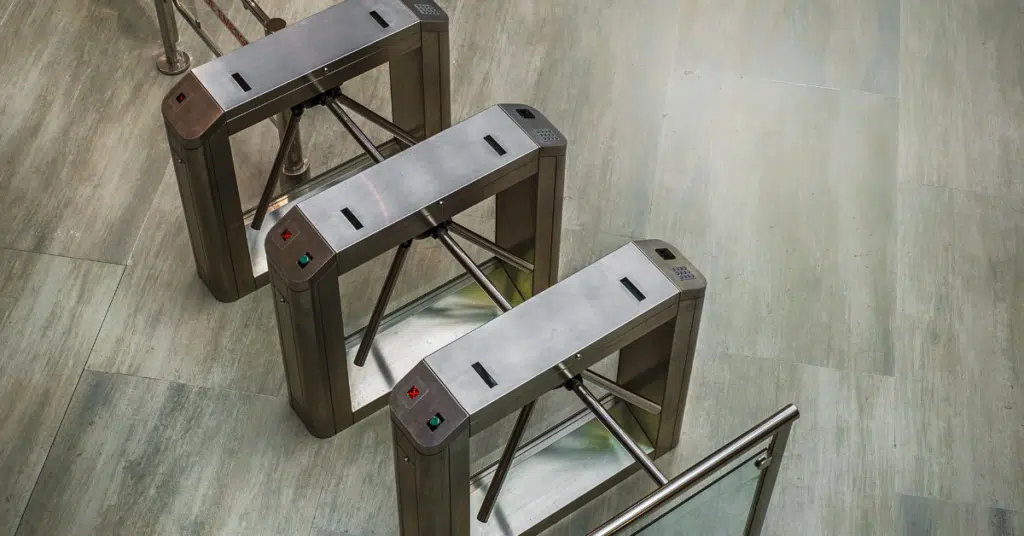
Cons
Unsurprisingly, all that talk of aesthetic and efficiency comes at a cost. A comparative lack of security.
Or rather, a need for additional security measures perhaps. Speed lanes are relatively easy to circumvent and we would not recommend them as the only security solution an independent gym or fitness club uses, especially if they are a 24/7 enterprise.
The ideal place of use for speedlanes is a traffic-heavy gym or fitness club in a relatively secure area that operates purely within daylight/business hours. As such, we would only recommend the speedlane as a specific solution for a specific type of gym, not a catch-all solution.
Full Height Turnstiles
Speaking of ‘jumping the turnstile’, here is one that even an olympic high-jumper might struggle to overcome.
Whether they go from floor to ceiling or merely stand at an imposing 2-meter-plus height. The full-height turnstile has become the emblem of access control for the 24-hour gym or fitness club. As such, we’ve seen both these systems rise in tandem, each helping the other succeed.
Has this beneficial relationship come to an end with the partial retreat of the 24-hour gym that has been witnessed over the last two years? Or is this only a temporary trend, quickly being undone? Time will tell, and we shall leverage our expertise to explore just what is in store for the full-height turnstile.
Pros
Able to offer unparalleled security whilst allowing for comparative ease of access. The full-height turnstile is an obvious candidate for the ‘heavy duty’ solution to gym access control. It is a striking statement of intent, a dedication to security, and a true investment.
The durable, all-encompassing nature of it means that it is one of the only access control solutions that offers full peace of mind while unmanned in a 24/7 gym or fitness club.
It all but ensures that the only way that a person is getting into the facility is with the appropriate verification method.
This is important to reassure both the management of a gym and the members. If someone is working out at 3am, they want to know that only the people who have paid to be within a facility can get in.
Finally, and perhaps what has given it a critical edge, is the relative ease of passage once verification has been provided. The full-height turnstile mechanism, for all of its bulk, is often easier to navigate than a more traditional turnstile.
Cons
So while the full-height turnstile is a fantastic solution for certain independent gyms and fitness clubs, specifically 24/7 facilities, that does not mean it is a catch-all solution or a silver bullet solution.
The fitness industry is complex and the answer to the best access control system is not as simple as merely purchasing the biggest option on the market.
And indeed, one of the key downsides to the full-height turnstile is cost. It is an expensive solution and one that will require more maintenance than cheaper options were they to break.
Furthermore, accessibility is another casualty. Unlike the much cheaper swing gates, not everyone will be able to comfortably navigate the full-height turnstile.
And lastly, space is a large consideration. Both in width and length, the full-height turnstile will take up significant room and will take time and space to install.
As such, while many independent gyms and fitness clubs should seriously consider the full-height turnstile as their access control solution, it is not a given. This is not one of those listicles where you can scroll to the bottom to get the best solution.
But with that being said, to many independent gyms and fitness clubs looking for security as they implement 24/7 or unmanned solutions, the full-height turnstile will be invaluable!
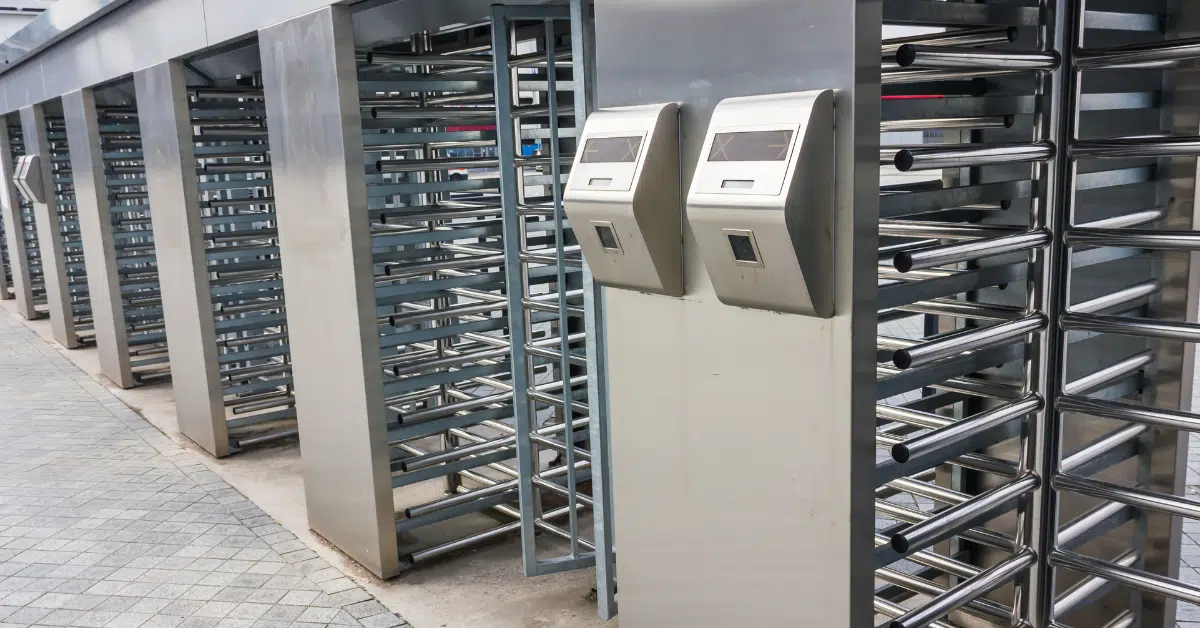
Our Access Control Roundup
And so the conclusion? If you’ve been reading then it should be apparent. Independent gyms and fitness clubs are so varied and specific (in fact it is one of their greatest strengths) that the answer was always going to be multi-faceted.
With that being said, we hope as the article has progressed that it has helped to eliminate certain solutions for certain requirements and parameters. For example, the 24/7 hour aspirant should now be fairly assured of the type of access control system that will most benefit a 24/7 gym or fitness club.
Furthermore, we hope that this look has reinforced how each system can help enhance the brand and image that an independent gym or fitness club is trying to project. Whether it is with an effortless speed lane or a hi-tech biometric scanner, each piece of equipment and verification method that we’ve gone through communicates something different.
The significant number of variables means that the best access control solution for one gym might not be the best for its nearest competitor. Whether it is based on the demographics that frequent the gym or fitness club, the space available, the opening hours or the number of staff members.
What this article hopes to achieve is a framework to interrogate each of those solutions in a constructive way, as presented by a company that has helped install thousands of them over the last 25 years.
If you are a new or veteran independent gym or fitness club owner with a desire to refresh, upgrade, or install the best access control system entry system for your facility, please do not hesitate to reach out and contact us.
Here at Ashbourne, we’ve been working with these systems for over twenty-five years, and with that twenty-five years come a level of confidence and dynamism that is hard to match. Our goal is to work with all of our independent gym and fitness club partners to deliver the solution that is correct for them, whether it is a verification system, access control system, or both!
Whether your gym is in a busy city centre or purely targeted at the older denizens of a small town. Whether it never shuts or operates in a very specific window. We are confident that our experience and expertise will give us an advantage in finding the best solution for your gym at the best price. Furthermore, our industry-respected club management software can help use this equipment, turning member access into meaningful data that can influence the very fabric of an independent gyms operations.
Don’t hesitate to arrange a demo with our team today on the following link!
More to Read...
Get your club in shape.
Want to discover how? Let us show you.
Simply select your preferred timeslot and we’ll be in touch to have a chat about your health club,
the goals you want to achieve, and how our system can help you.
the goals you want to achieve, and how our system can help you.
Get your club in shape.
Want to discover how? Let us show you.
Simply select your preferred timeslot and we’ll be in touch to have a chat about your health club, the goals you want to achieve, and how our system can help you.
Get your club in shape.
Want to discover how? Let us show you.
Simply select your preferred timeslot and we’ll be in touch to have a chat about your health club, the goals you want to achieve, and how our system can help you.
